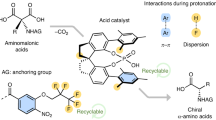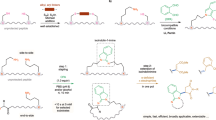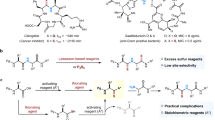Abstract
Nature excels at performing selective modifications of complex polyfunctional molecules by tailoring enzymes, but synthetic chemistry has lagged behind in this regard. In prior work, we have applied a biomimetic approach to this problem, developing small peptides to achieve various group transfer reactions on polyol substrates with high enantio- or regioselectivity. The use of sulfonates as synthetic building blocks and the scarcity of direct, selective methods for their preparation prompted our investigation into this area. In this article we report the development of a π-methyl histidine-based tetrameric peptide that effects the desymmetrization of meso-1,3-diols through enantioselective mono(sulfonylation). The catalyst exhibits structural similarities to another catalyst found to be effective in orthogonal group transfers, but results in modification of the enantiotopic alcohol. The practical and mechanistic implications of this discovery may extend beyond synthetic considerations and provide analogies to the diverse roles of histidine in enzyme active sites.
This is a preview of subscription content, access via your institution
Access options
Subscribe to this journal
Receive 12 print issues and online access
$259.00 per year
only $21.58 per issue
Buy this article
- Purchase on Springer Link
- Instant access to full article PDF
Prices may be subject to local taxes which are calculated during checkout





Similar content being viewed by others
References
Peddibhotla, S., Dang, Y., Liu, J. O. & Romo, D. Simultaneous arming and structure/activity studies of natural products employing O–H insertions: an expedient and versatile strategy for natural products-based chemical genetics. J. Am. Chem. Soc. 129, 12222–12231 (2007).
Miller, S. J., Copeland, G. T., Papaioannou, N., Horstmann, T. E. & Ruel, E. M. Kinetic resolution of alcohols catalyzed by tripeptides containing the N-alkylimidazole substructure. J. Am. Chem. Soc. 120, 1629–1630 (1998).
Copeland, G. T. & Miller, S. J. Selection of enantioselective acyl transfer catalysts from a pooled peptide library through a fluorescence-based activity assay: an approach to kinetic resolution of secondary alcohols of broad structural scope. J. Am. Chem. Soc. 123, 6496–6502 (2001).
Sculimbrene, B. R. & Miller, S. J. Discovery of a catalytic asymmetric phosphorylation through selection of a minimal kinase mimic: a concise total synthesis of d-myo-inositol-1-phosphate. J. Am. Chem. Soc. 123, 10125–10126 (2001).
Evans, J. W., Fierman, M. B., Miller, S. J. & Ellman, J. A. Catalytic enantioselective synthesis of sulfinate esters through the dynamic resolution of tert-butanesulfinyl chloride. J. Am. Chem. Soc. 126, 8134–8135 (2004).
Sánchez-Roselló, M., Puchlopek, A. L. A., Morgan, A. J. & Miller, S. J. Site-selective catalysis of phenyl thionoformate transfer as a tool for regioselective deoxygenation of polyols. J. Org. Chem. 73, 1774–1782 (2008).
Zhao, Y., Rodrigo, J., Hoveyda, A. H. & Snapper, M. L. Enantioselective silyl protection of alcohols catalysed by an amino-acid-based small molecule. Nature 443, 67–70 (2006).
Ishihara, K., Kosugi, Y., Umemura, S. & Sakakura, A. Kinetic resolution of racemic carboxylic acids by an l-histidine-derived sulfonamide-induced enantioselective esterification reaction. Org. Lett. 10, 3191–3194 (2008).
Lewis, C. A. & Miller, S. J. Site-selective derivatization and remodeling of erythromycin A by using simple peptide-based chiral catalysts. Angew. Chem. Int. Ed. 45, 5616–5619 (2006).
Lewis, C. A., Merkel, J. & Miller, S. J. Catalytic site-selective synthesis and evaluation of a series of erythromycin analogs. Bioorg. Med. Chem. Lett. 18, 6007–6011 (2008).
Peltier, H. M., Evans, J. W. & Ellman, J. A. Catalytic enantioselective sulfinyl transfer using cinchona alkaloid catalysts. Org. Lett. 7, 1733–1736 (2005).
Shibata, N., Matsunaga, M., Fukuzumi, T., Nakamura, S. & Toru, T. Cinchona alkaloid-sulfinyl chloride combinations: catalytic enantioselective sulfinylation of alcohols. Synlett 1699–1702 (2005).
Demizu, Y., Matsumoto, K., Onomura, O. & Matsumura, Y. Copper complex catalyzed asymmetric monosulfonylation of meso-vic-diols. Tetrahedron Lett. 48, 7605–7609 (2007).
Onomura, O., Mitsuda, M., Nguyen, M. T. T. & Demizu, Y. Asymmetric tosylation of racemic 2-hydroxyalkanamides with chiral copper catalyst. Tetrahedron Lett. 48, 9080–9084 (2007).
Demizu, Y., Kubo, Y., Matsumura, Y. & Onomura, O. Nonenzymatic kinetic resolution of 3-hydroxyalkanamides with chiral copper catalyst. Synlett 433–437 (2008).
Sibi, M. P. & Liu, M. Reversal of stereochemistry in enantioselective transformations. Can they be planned or are they just accidental? Curr. Org. Chem. 5, 719–755 (2001).
Sculimbrene, B. R., Morgan, A. J. & Miller, S. J. Enantiodivergence in small molecule catalysis of asymmetric phosphorylation: concise total syntheses of the enantiomeric d-myo-inositol-1-phosphate and d-myo-inositol-3-phosphate. J. Am. Chem. Soc. 124, 11653–11656 (2002).
Haque, T. S., Little, J. C. & Gellman, S. H. Stereochemical requirements for β-hairpin formation: model studies with four-residue peptides and depsipeptides. J. Am. Chem. Soc. 118, 6975–6985 (1996).
Asano, K. & Matsubara, S. Amphiphilic organocatalyst for Schotten-Baumann-type tosylation of alcohols under organic solvent free condition. Org. Lett. 11, 1757–1759 (2009).
Lewis, C. A., Chiu, A., Kubryk, M., Balsells, J., Pollard, D., Esser, C. K., Murry, J., Reamer, R. A., Hansen, K. B. & Miller, S. J. Remote desymmetrization at near-nanometer group separation catalyzed by a miniaturized enzyme mimic. J. Am. Chem. Soc. 128, 16454–16455 (2006).
Lewis, C. A., Gustafson, J. L., Chiu, A., Balsells, J., Pollard, D., Murry, J., Reamer, R. A., Hansen, K. B. & Miller, S. J. A case of remote asymmetric induction in the peptide-catalyzed desymmetrization of a bis(phenol). J. Am. Chem. Soc. 130, 16358–16365 (2008).
Schreiber, S. L., Schreiber, T. S. & Smith, D. B. Reactions that proceed with a combination of enantiotopic group and diastereotopic face selectivity can deliver products with very high enantiomeric excess: experimental support of a mathematical model. J. Am. Chem. Soc. 109, 1525–1529 (1987).
Copeland, G. T., Jarvo, E. R. & Miller, S. J. Minimal acylase-like peptides. Conformational control of absolute stereospecificity. J. Org. Chem. 63, 6784–6785 (1998).
Denmark, S. E. & Beutner, G. L. Lewis base catalysis in organic synthesis. Angew. Chem. Int. Ed. 47, 1560–1638 (2008).
Pirrung, M. C. Histidine kinases and two-component signal transduction systems. Chem. Biol. 6, R167–R175 (1999).
Jencks, W. P. Catalysis in Chemistry and Enzymology 218–226 (Dover, 1975).
Anantharaman, V., Aravind, L. & Koonin, E. V. Emergence of diverse biochemical activities in evolutionarily conserved structural scaffolds of proteins. Curr. Opin. Chem. Biol. 7, 12–20 (2003).
Yoon, T. P. & Jacobsen, E. N. Privileged chiral catalysts. Science 299, 1691–1693 (2003).
Acknowledgements
This work is supported by the National Institutes of Health (NIH) (GM-068649). K.W.F. would like to thank the NIH for a postdoctoral fellowship (1F32GM083622).
Author information
Authors and Affiliations
Contributions
All authors conceived and designed the experiments and analysed the data. K.W.F and A.L.A.P. performed the experiments, K.W.F and S.J.M. wrote the paper jointly, and all authors edited and commented on the manuscript.
Corresponding author
Supplementary information
Supplementary information
Supplementary information (PDF 4187 kb)
Rights and permissions
About this article
Cite this article
Fiori, K., Puchlopek, A. & Miller, S. Enantioselective sulfonylation reactions mediated by a tetrapeptide catalyst. Nature Chem 1, 630–634 (2009). https://doi.org/10.1038/nchem.410
Received:
Accepted:
Published:
Issue Date:
DOI: https://doi.org/10.1038/nchem.410
This article is cited by
-
A synergistic Rh(I)/organoboron-catalysed site-selective carbohydrate functionalization that involves multiple stereocontrol
Nature Chemistry (2023)
-
Cu-catalysed enantioselective radical heteroatomic S–O cross-coupling
Nature Chemistry (2023)
-
Diastereoselective desymmetric 1,2-cis-glycosylation of meso-diols via chirality transfer from a glycosyl donor
Nature Communications (2020)
-
Catalytic asymmetric acetalization of carboxylic acids for access to chiral phthalidyl ester prodrugs
Nature Communications (2019)
-
Peptide-catalyzed stereoselective Michael addition of aldehydes and ketones to heterocyclic nitroalkenes
Monatshefte für Chemie - Chemical Monthly (2018)



